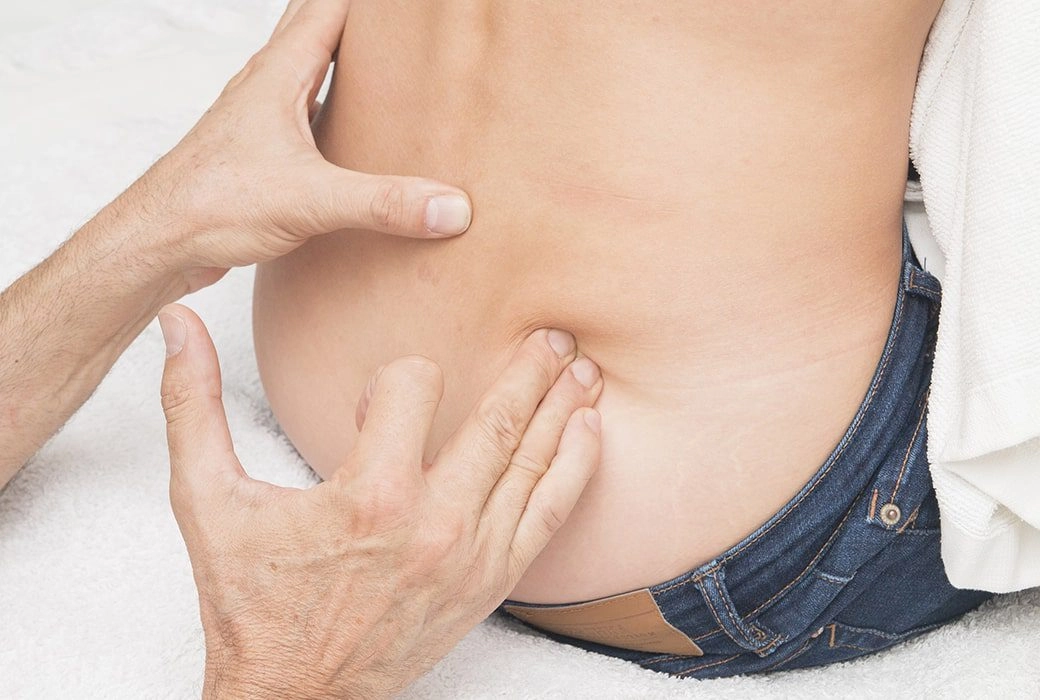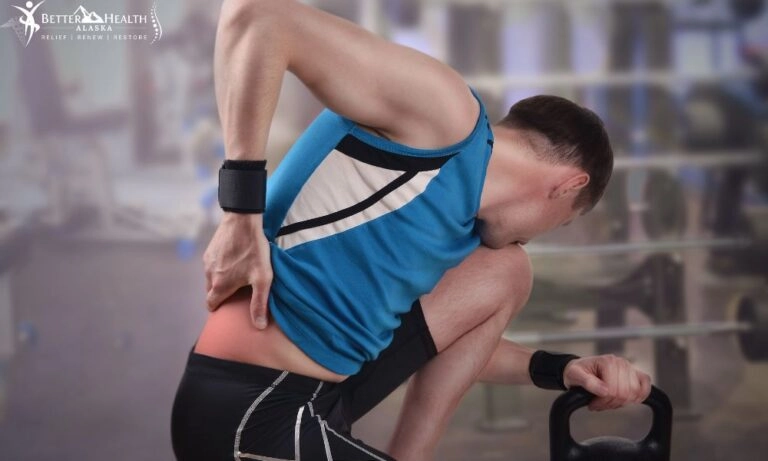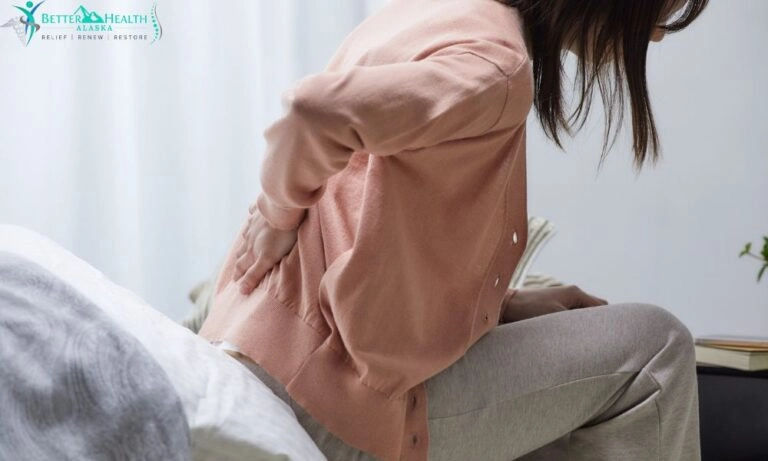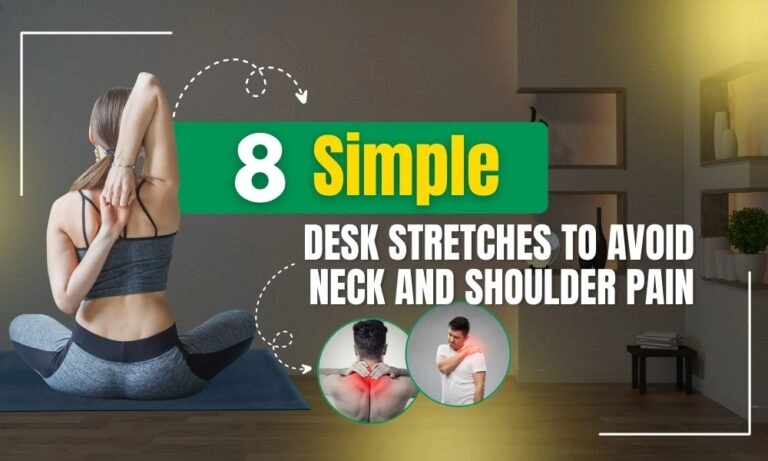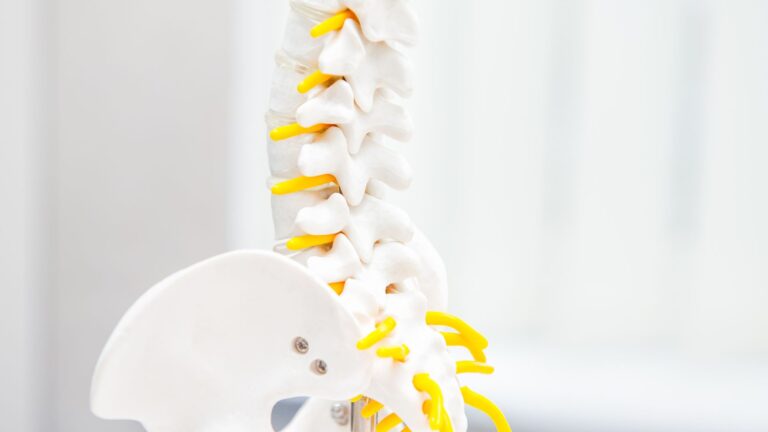Our Anchorage chiropractors at Better Health Alaska understand that uneven or misaligned hips can cause discomfort throughout the body. Luckily, misaligned hips only have a few key causes, and a solution works for all of them. Read on to find out how to fix uneven hips safely and effectively.
Fixing uneven hips usually involves stretching, exercising, wearing a special brace, or utilizing a heel lift. Surgery is the best answer in some severe cases, but most uneven hips can be corrected with the right conservative treatments.
The Problem with Uneven Hips
Individuals with uneven hips can experience various issues due to this imbalance. Here are some common problems:
- Back Pain: Misalignment in the hip often leads to discomfort and strain in the lower back.
- Postural Issues: Uneven hips can result in poor posture, altering the body’s natural alignment.
- Walking Difficulties: The imbalance may cause an unusual gait, making walking uncomfortable or problematic.
- Joint Pain: Uneven hips put a strain on other joints in the body, leading to pain in the knees, ankles, and even the shoulders.
- Muscle Imbalance: This condition may result in some muscles becoming overworked while others are underused, leading to an overall muscle imbalance.
- Decreased Mobility: Over time, uneven hips can limit the range of motion, affecting daily activities and overall quality of life.
- Increased Risk of Injuries: The added strain and imbalances caused by uneven hips can lead to a higher risk of injuries, particularly in the lower body.
How to Realign Hips?
If you’ve determined that your hips are uneven, you have a couple of options for moving forward. If you’re an adult who has never been diagnosed with scoliosis and never had severe hip issues before, it’s likely that performing the following exercises at home or visiting a trusted Anchorage chiropractor will remedy the problem safely and effectively.
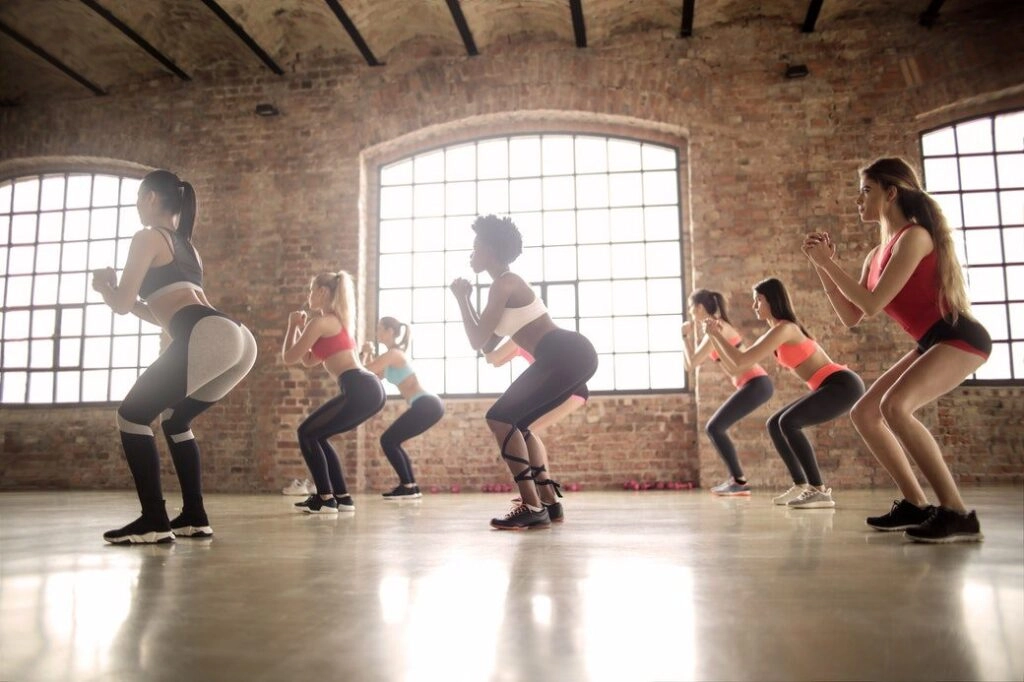
1) Self Hip Adjustment Exercises
Uneven hips are often caused by years of favoring one leg, poor posture, improper sitting position(1), improper lifting techniques, weight gain, and even crossing your legs. As such, these exercises(2) mainly aim to stretch and strengthen the muscles on one or both sides of your body to bring the hips back even again.
2) Hip Realignment
- Lie on your back, raise your legs up, and place your feet against the wall so that your knees are at a 90-degree angle.
- Press your foot into the wall using the leg muscles with the higher hip.
- Press the hip on the same side toward the wall using your hand.
- Hold for 10 to 20 seconds.
- Repeat 12 to 15 times.
3) Standing Reverse Leg Raises
- Stand up straight with your feet comfortably apart.
- Engage your core to keep your spine and body straight.
- Raise one leg behind you comfortably without bending the knee or your upper body.
- Bring your leg back down, touching your toe to the floor.
- Perform 12 to 15 repetitions.
- Switch legs and repeat.
- Be sure to use controlled movements and to keep your core engaged as you do this. Avoid using momentum to swing the leg, as this will defeat the purpose of the exercise.
4) 90/90 Hip Stretch
- On a yoga mat or a comfortable floor, sit down and arrange your left leg in front of you with the outside of your knee and ankle on the floor and the knee at 90 degrees.
- Make sure the left knee is in line with the left hip.
- Arrange your right leg out to your right side at a 90-degree angle, with the inside of the knee and ankle on the floor.
- Keeping your spine as straight as possible, reach forward with your left hand, pushing your left hip back as you do so.
- Hold for 5 to 10 seconds. Repeat 5 to 8 times.
- Reverse the position and do the same for the right side.
These are just a few exercises that help stretch and strengthen your hips’ muscles. Doing yoga regularly, primarily concentrating on moves that involve the hips, can help you to correct any misalignment you may have.
5) Chiropractic Care for Misaligned Hips in Anchorage, AK
If you feel like you aren’t making progress working on your hips at home, or the pain isn’t receding, you may consider seeking chiropractic care at your local Anchorage healthcare office. Hip adjustments are a common practice among chiropractors. Plus, a doctor of chiropractic may perform or recommend other treatment options to safely and effectively speed the realignment process. These may include:
- Chiropractic massage
- Posture correction treatment
- Adjustments for sciatica pain
- Weight loss tips
- Lifestyle tips
- Additional exercises and stretches
How to Pop Your Hip?
We would be remiss if we didn’t mention hip popping in this article. The popping of joints, especially in the back and hips, is familiar to many people. Sometimes what feels like a misaligned hip needs to be popped. Many people complain of a hip that feels like it needs to pop but won’t. Knowing how to pop your hip safely at home can make all the difference in comfort and mobility. But, you should never perform an exercise or stretch that causes you pain.
Seated Hip Stretch
Many people find this to be the best stretch for popping a hip.
- Sit in a chair with both feet on the ground.
- Raise the leg of the affected hip and place the ankle across the knee of the opposite leg.
- Lean forward slightly and press your hand directly down on the raised knee.
- Hold the position for 5 to 8 seconds.
- Repeat 3 to 5 times before changing sides.
Side Lunge
- Stand up with your feet set about twice as wide as the hips.
- Clasps your hands together in front of your chest for balance.
- Lean to the right in a lunge, allowing the left leg to stretch out, placing most of your body weight on the strong right leg.
- Get as low as is comfortable and hold the stretch for several seconds.
- Raise back up.
- Repeat 5 to 8 times on each side.
If your hip doesn’t pop while doing these exercises, don’t force it. Only do as many of these exercises as you’re comfortable with. Seek professional help if the hip doesn’t pop or starts to cause you pain after a week. You should also see a medical professional if you feel pain when the hip pops. If the cause of your uneven hips is scoliosis, the good news is that a chiropractor can help with that too.
Benefits of Fixing Uneven Hips
Fixing uneven hips can help you improve your posture and balance, reduce the risk of injuries, experience less pain in general, and have more energy. Good alignment allows all structures to be in optimal positions to provide stability and support for our movements. When the hips are misaligned, it can put more strain and stress on other joints, leading to pain and fatigue.
Correcting uneven hips is beneficial as it puts your body back into balance. This helps you move with less effort and greater control, making everyday activities such as walking or climbing stairs much easier. In addition, restoring balance can help reduce pain in the hips and lower back, and other surrounding areas such as the knees and feet.
Finally, fixing uneven hips also helps to improve overall posture. Poor posture, as your Anchorage chiropractor will tell you, can cause many problems, including neck and shoulder pain, headaches, crunching of the spine, muscle tension, difficulty breathing, and fatigue. When these issues are corrected, you can experience an improved quality of life with more energy and less pain.
Chiropractic Exercises to Maintain Hip Alignment in Anchorage, AK
Once you have corrected your uneven hips, it’s important to maintain that alignment. Regular physical activity plays a crucial role in this regard. Strengthening exercises can be beneficial, as they build the muscles that support your hips, thus helping to maintain the correct position. Meanwhile, flexibility exercises can release tight muscles that might pull your hips out of alignment. Here are a few exercises that can help:
a. Hip Flexor Stretches: These stretches can help keep your hip flexors—the muscles along the front of the hips—flexible, thus preventing them from pulling your hips into an incorrect position.
b. Squats: This full-body exercise strengthens the glutes, quads, and core muscles, which all provide support to your hips.
c. Planks: This popular core workout also strengthens your glutes, which are crucial for hip support.
d. Pilates and Yoga: These mind-body exercises are excellent for both strength and flexibility. They focus on the core, including the hips, and many moves can help maintain hip alignment.
Regular exercise and stretching can help you maintain proper hip alignment, but remember that everyone’s body is different. Always consult a healthcare professional before starting any new exercise routine for uneven hips, hip labral tears, or other hip problems.
Scientific Evidence Supporting Hip Alignment Exercises
Various studies published in reputable scientific journals highlight the importance and benefits of regular exercise for maintaining hip alignment. One such study, published in the Journal of Physical Therapy Science, emphasizes the significance of hip abductor strengthening for improving hip alignment, particularly in individuals with Patellofemoral Pain Syndrome.
Another study in the Clinical Biomechanics Journal demonstrated that a specific exercise program focusing on hip muscle strengthening can effectively help correct hip drop and improve walking and running gait in individuals with hip alignment issues.
Furthermore, the Journal of Orthopaedic & Sports Physical Therapy conducted a study that showed a significant improvement in hip joint strength and function post hip arthroscopy surgery with a dedicated exercise regimen focusing on hip muscles.
These findings collectively suggest that specific strengthening exercises can play a pivotal role in maintaining proper hip alignment, reducing pain, and enhancing overall quality of life.
Hip Out of Alignment Symptoms
Having hips out of alignment can be a scary prospect. You may think that one leg has grown longer than the other or that you have scoliosis. However, most hip misalignments among adults happen over time and can be fixed with the proper stretches and exercises. Most of the time, it can be handled at home or with the help of chiropractic care. Here are some symptoms indicating that your hips are out of alignment:
- Hip pain
- Foot, leg, or ankle pain
- Back pain (upper or lower)
- Sciatica
- Tightness in the muscles of the affected side
- Uneven shoulders
- The feeling that one leg is longer than the other
The Causes of Misaligned Hips
When seeking the proper treatment for uneven hips, knowing the different causes is essential.
a) Functional Leg Length Discrepancy
This is the most common type of hip misalignment, which includes lateral pelvic tilt, which can happen to anyone and is usually the result of tight muscles on one side of the body. This will be the main focus of this article.
b) Scoliosis
Most common among children or adolescents, this curving of the spine can result in uneven hips and shoulders. In extreme cases, it’s often treated by observation, a special brace, or surgery.
c) Difference in Leg Length
When one leg is longer than the other, it affects the hips, the spine, and the shoulders. This is often treated by a heel insert in mild cases and surgery in extreme cases.
Hip Alignment Test
You can do a simple test at home to help you determine whether your hips are uneven. Of course, this is not a replacement for seeing a medical professional, but it can give you an idea of whether or not your hips are really out of alignment.
- Stand in front of a mirror in your bare feet.
- Grab a piece of string, a shoelace, or a workout band, and hold one end in each hand.
- Place the heels of your hands directly on your hip bones.
- Check in the mirror to see if the string is tilted. If it is, your hips are likely uneven.
Visiting an Anchorage Chiropractor for Uneven Hips
Having uneven hips can cause problems all throughout the body. But with proper care, you’ll be surprised at how quickly you experience pain relief, better movement, and fewer problems. The best way to do this is to see a chiropractor in Anchorage who can locate and address the root cause of the problem. To fix your uneven hips, visit us at our Better Health Alaska Chiropractors office for a hip adjustment that promises 100% satisfaction care to patients.
Sources:
1. https://www.tandfonline.com/doi/abs/10.1179/106698104790825239
2. https://www.healthline.com/health/fitness-and-exercise/lateral-pelvic-tilt-exercise#diagnosis



